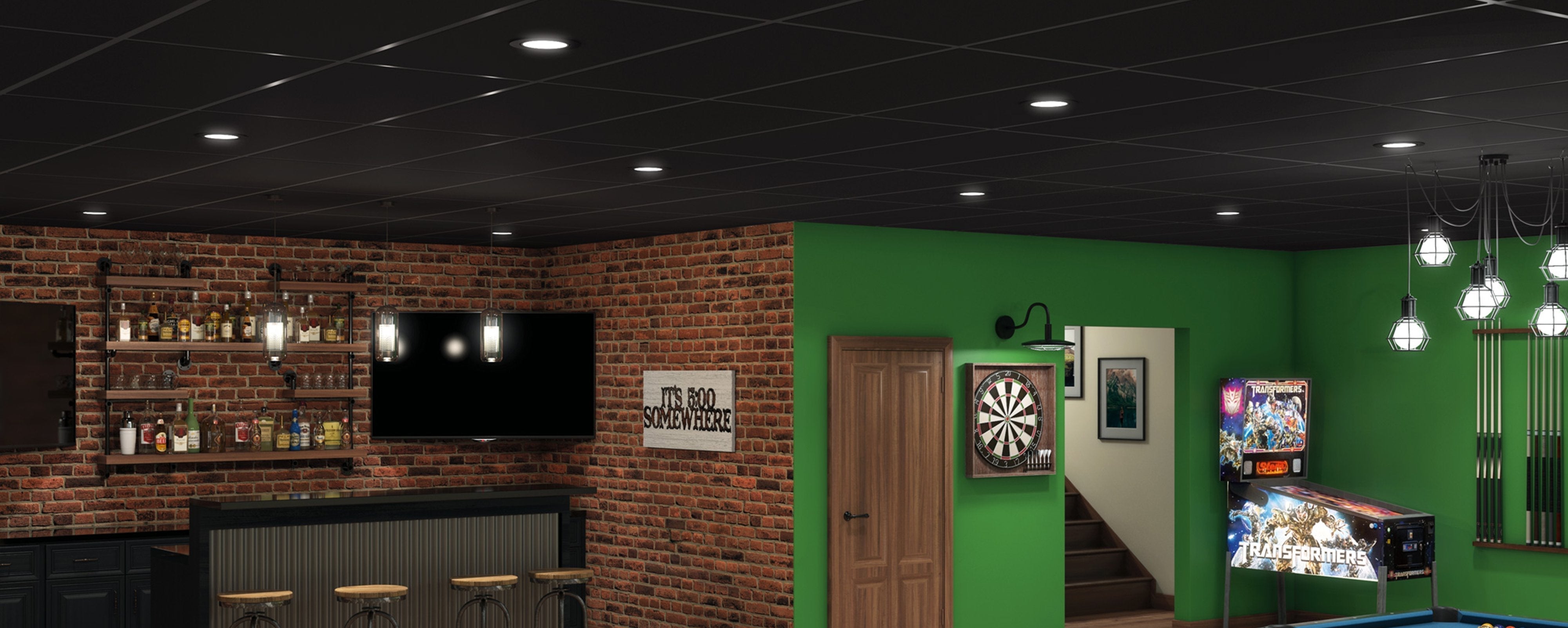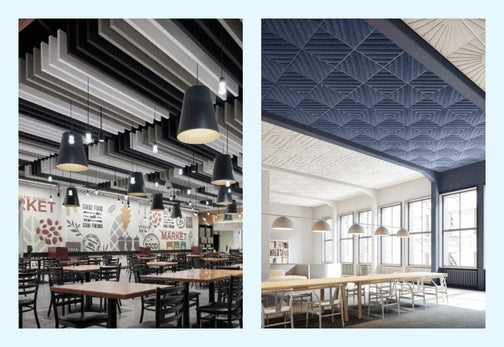Ceiling Soundproofing Guide

Whether you’re in a high-rise or a building with just a few levels, ceiling soundproofing is important to preserving a comfortable environment for everyone in your commercial or residential space.
While people may not be shouting over the sound of a jackhammer, even low-level noise can have negative impacts on our satisfaction, comfort and overall health.
Understanding the different types of noise and how to mitigate their effects will go a long way toward increasing productivity and satisfaction in any space.
Airborne noise vs. impact noise
Airborne noise is sound that travels through the air. These noises include music, conversations, typing, ringing and machines, and travel within the open spaces of a structure as waves.
Impact noise is a result of, you guessed it, impacts. Footsteps, dropped books, rolling office chairs and thuds from slamming doors all contribute to impact noise.
Understanding how to soundproof a ceiling from impact noise can make a substantial difference in creating a comfortable environment.
Ceiling Soundproofing Steps
There are many ways to sound block a ceiling. The solutions listed below can help soundproof between floors and create a quiet and more comfortable environment.
(Extra tip: You can choose more than one of these solutions for optimal results.)
Decoupling
Decoupling means separating structural elements to create space between them. This space then disrupts the travel of soundwaves. By design, drop ceilings are already decoupled as there is a gap between the drop ceiling and structural ceiling.
To increase the efficiency of decoupling, you can spray insulation into the rafters, adding soundproofing while maintaining the space between the ceiling tiles and structural ceiling. However, it’s important that the insulation does not lay on the drop ceiling.
Absorption
Sound absorption is essentially when an object absorbs the soundwaves that try to bounce off of it, reducing the noise in a space. Ceiling tiles are manufactured with low-density materials like fiberglass, mineral wood or foam that will absorb airborne noise, creating additional soundproofing between floors and a more comfortable space within the room. Acoustic ceiling tiles from Kanopi by Armstrong can absorb up to 95% of ambient sound within a space.
Mass
Adding additional materials in-between the floors helps to absorb sound, and the extra mass forces sound to pass through more layers. Adding additional wall protection material or underlayment along with flooring achieves more mass for better sound blocking.
Blocking
Sound blocking happens when a material literally blocks sound from traveling. Sound blocking ceiling tiles stop sound transmission and block noise from disturbing people in the rooms next door, above or below.
How to soundproof a ceiling between floors
Add insulation
When you’re deciding how to soundproof a drop ceiling, insulation is one of the first considerations. Insulating the space in between the structural ceiling and drop ceiling will create a barrier between the floors, not only helping to maintain temperature but also reducing sound transfer between floors.
Install flooring underlayment
Underlayment comes in a variety of materials, some better suited for reducing sound between floors than others. Common materials include cork sheet, polypropylene foam, felt and acoustic foam.
This one is nice to plan for if you’re thinking about redoing the flooring in your building or home. Flooring underlayment is installed under the flooring whether wood, laminate, tile, linoleum or carpet. Choosing the proper underlayment for your flooring results in substantial soundproofing between floors.
Apply a sound-damping material
Sound-damping material dulls the vibrations that create sound reverberations throughout a space. Soundproof paint and other wall materials can help absorb sound, creating a quieter and more comfortable space.
Install acoustic-rated ceiling tiles
By far, the easiest and most effective soundproofing solution is installing acoustical ceilings. Integrating a drop ceiling has a range of benefits, from hiding wiring and ductwork to providing a space for additional soundproofing insulation. The ceiling tiles of the drop ceiling itself, when acoustically rated, will provide the noise reduction needed between floors.
Acoustic-rated ceiling tiles

ULTIMA Lay-in & tegular ceiling tiles provide excellent sound blocking and sound absorption to ensure a comfortable acoustic environment for your healthcare facility, office or school. They also offer light resistance and sustainability in a durable ceiling tile perfect for your space.
For modern offices, salons, healthcare facilities and schools, drop ceilings allow you to soundproof between floors to create a comfortable and productive space. The fine, non-directional texture makes DUNE ceiling tiles easier to install. This economical solution will help absorb sound while looking beautiful in a modern space.
The angled stepped corners on the MESA second look ceiling tiles create a softer look for a sense of sophistication. As a drop ceiling, these fine-textured visual panels complete the look while offering soundless rooms.

Available in a variety of edge profiles, grid sizes, tile sizes and colors, CIRRUS ceiling tiles allow you to customize the medium-texture tiles to your specifications.
Difference is audible
Integrating a drop ceiling into your room design helps to soundproof the space, and you can increase the level of soundproofing even further by choosing acoustic ceiling tiles from Kanopi. With options to customize the look and choose the right level of sound absorption and sound-blocking, you’ll hear the difference.
Contact an expert at Kanopi today to take the next step towards a quieter space.
FAQ's
Can you soundproof an existing ceiling?
Yes. You can soundproof an existing drywall ceiling by attaching acoustical panels to the ceiling. If the existing ceiling is a drop ceiling, simply replace the current ceiling tiles with sound blocking tiles.
What is the best way to soundproof the ceiling?
The best way to soundproof a ceiling is to use acoustical ceiling tiles. Acoustical ceiling tiles will absorb the sound within the space and they will also block outside sound from entering the space.
What is the cheapest way to soundproof a ceiling?
The cheapest way to soundproof a ceiling is to add acoustical ceiling tiles. Acoustical ceiling tiles will absorb the sound within the space and they will also block outside sound from entering the space.
Why would I need to soundproof my ceiling?
Ceiling soundproofing is essential for:
-
Reducing noise from upstairs neighbors or floors
-
Blocking airborne sounds (like voices or music)
-
Minimizing impact noise (footsteps, dropped items)
-
Improving room acoustics (for home offices, studios, or theaters)
-
Enhancing privacy between floors
Are drop ceilings good for soundproofing?
Standard drop ceilings aren’t great for soundproofing on their own. However, if paired with:
-
Acoustic tiles
-
Insulation above the tiles
-
Specialized sound-rated ceiling panels
Can I soundproof a basement ceiling?
Yes—and it’s highly recommended for multi-use spaces. Use:
-
Acoustic insulation between joists
-
Decoupled drywall with Green Glue
-
Acoustic ceiling tiles (if using a drop ceiling) This reduces both noise from the main floor and sound traveling upward.
How effective is soundproofing a ceiling?
Properly installed soundproofing can reduce noise transmission by 50–80%, depending on the methods and materials used. Total silence is rare, but significant improvement in noise reduction is very achievable.
How much does it cost to soundproof a ceiling?
Costs vary widely:
-
DIY ceiling panels or insulation: $2–$4 per sq. ft.
-
Full professional soundproofing (resilient channels, drywall, insulation): $8–$20 per sq. ft.
Can I install ceiling soundproofing myself?
Yes, especially if you’re:
-
Comfortable with basic construction tasks
-
Installing panels or drop ceiling tiles
-
Adding MLV or insulation
More advanced installations (like isolation clips and multi-layer drywall) are best left to professionals for maximum effectiveness.
Are there soundproof ceiling options for apartments or renters?
Yes! Consider:
-
Acoustic ceiling panels (temporary and removable)
-
Hanging soundproofing panels or baffles
-
Layered fabric tiles
-
Thicker rugs or foam mats upstairs (if applicable)
Avoid major structural changes unless you have landlord permission.





 Thanks for subscribing!
Thanks for subscribing!

